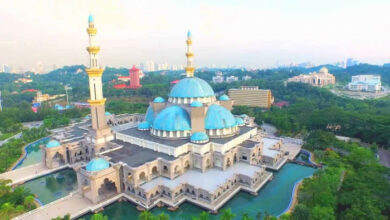The Qibla Wall: A Masterpiece of Islamic Calligraphy and Modern Technology

The Qibla Wall is an essential feature of every mosque, indicating the direction of Mecca (Qibla) towards which Muslims face during prayers. In the Sheikh Zayed Grand Mosque in Abu Dhabi, the Qibla Wall is not only functional but also an extraordinary work of art. This article explores the intricate design and unique features of the Qibla Wall that make it a significant and captivating element of the mosque.
Architectural Brilliance
The Qibla Wall in Sheikh Zayed Grand Mosque is a stunning example of the fusion between traditional Islamic art and modern technology.
Inscription of the 99 Names of Allah:
- Traditional Kufic Calligraphy: The wall is inscribed with the 99 names of Allah, known as Asma Ul Husna, in traditional Kufic calligraphy. This ancient script is characterized by its angular and geometric shapes, giving the inscriptions a timeless and sacred feel.
- Artistic Significance: The calligraphy on the Qibla Wall is not just decorative; it serves as a spiritual reminder of the divine attributes of Allah, enhancing the prayer experience for worshippers.
Fiber-Optic Lighting:
- Illuminated Calligraphy: The Qibla Wall features a sophisticated fiber-optic lighting system that makes the calligraphy glow subtly. This lighting not only highlights the beauty of the inscriptions but also creates a serene and reflective ambiance.
- Modern Technology: The use of fiber-optic lighting represents the integration of modern technology with traditional Islamic art, showcasing the innovative approach taken in the design of Sheikh Zayed Grand Mosque.
Spiritual and Cultural Significance
The Qibla Wall is not merely an architectural feature; it holds profound spiritual and cultural importance.
Direction of Prayer:
- Spiritual Orientation: The Qibla Wall ensures that worshippers are correctly oriented towards Mecca during their prayers, a fundamental aspect of Islamic worship.
- Unified Worship: By facing the Qibla, Muslims around the world pray in unison, symbolizing unity and solidarity within the global Muslim community.
Cultural Heritage:
- Preservation of Art: The use of Kufic calligraphy on the Qibla Wall helps preserve this traditional art form, passing down its beauty and significance to future generations.
- Educational Value: The Qibla Wall serves as an educational piece, allowing visitors to learn about the 99 names of Allah and the cultural heritage of Islamic calligraphy.
Visiting the Qibla Wall
For those interested in experiencing the beauty and significance of the Qibla Wall, a visit to Sheikh Zayed Grand Mosque is a must.
Guided Tours:
- In-Depth Information: Free guided tours are available, providing detailed information about the Qibla Wall and other architectural features of the mosque. These tours are led by knowledgeable guides who offer insights into the historical and cultural context of the mosque’s design.
Photography:
- Capturing the Beauty: Visitors are encouraged to take photographs of the Qibla Wall, particularly to capture the stunning effect of the illuminated calligraphy. However, it is important to be respectful and avoid taking photos during prayer times.
Conclusion
The Qibla Wall in Sheikh Zayed Grand Mosque is a masterpiece that beautifully combines traditional Islamic calligraphy with modern lighting technology. Its intricate design and spiritual significance make it a captivating feature that enhances the overall experience of the mosque. Whether you are a worshipper, an art enthusiast, or a curious traveler, the Qibla Wall offers a unique and enriching glimpse into the harmonious blend of heritage and innovation in Islamic architecture


